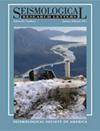2019年山脊地震地表破裂的远程测绘再现性
IF 3.2
3区 地球科学
Q2 GEOCHEMISTRY & GEOPHYSICS
引用次数: 0
摘要
我们使用2019年山脊地震序列的多个独立制作的地表破裂图来测试地表破裂图解释的可重复性和完整性。7月4日的6.4兆瓦和7月5日的7.1兆瓦地震分别产生了大约20公里和50公里长的地表破裂带。三位具有不同活动构造背景的独立制图者在没有震后场或大地测量观测知识的情况下,利用地震后激光雷达数据绘制了地表破裂图。三幅远距离断裂图的目视比较显示高度为50厘米的断崖高度一致。对于地形表达较少的特征,不同制图者对数据的解释差异更大。定量地图比较在具有1m缓冲区的映射线之间的一致性范围为18%到54%。重叠的百分比随着缓冲区宽度的增加而增加,这反映了线放置的差异以及断层带解释的差异。总体而言,地表破裂较为简单且垂直偏移较多的地区的地图相似性高于破裂模式复杂或垂直偏移较少的地区。断层带解释解释了地图之间的最大差异,而线的放置解释了米尺度上的差异。与现场观察结果相比,我们的远程制作的地图可以很好地捕捉到主要破裂,但遗漏了小特征和几何复杂性。总的来说,激光雷达擅长于探测和测量景观中的垂直偏移量,而在探测很少或没有垂直运动的横向偏移量方面存在不足。本文章由计算机程序翻译,如有差异,请以英文原文为准。
Reproducibility of Remote Mapping of the 2019 Ridgecrest Earthquake Surface Ruptures
Abstract We use multiple, independently produced surface-rupture maps of the 2019 Ridgecrest earthquake sequence to test the reproducibility of surface-rupture map interpretation and completeness. The 4 July Mw 6.4 and 5 July Mw 7.1 earthquakes produced surface-rupture zones approximately 20 and 50 km in length, respectively. Three independent mappers with various backgrounds in active tectonics mapped the surface rupture from the postearthquake lidar data without knowledge from postearthquake field or geodetic observations. Visual comparisons of the three remote rupture maps show good agreement for scarps >50 cm in height. For features with less topographic expression, interpretations of the data vary more widely between mappers. Quantitative map comparisons range from 18% to 54% consistency between mapped lines with 1 m buffers. The percent overlap increases with buffer width, reflecting variance in line placement as well as differences in fault-zone interpretation. Overall, map similarity is higher in areas where the surface rupture was simpler and had more vertical offset than in areas with complex rupture patterns or little vertical offset. Fault-zone interpretation accounts for the most difference between maps, while line placement accounts for differences at the meter scale. In comparison to field observations, our remotely produced maps capture the principal rupture well but miss small features and geometric complexity. In general, lidar excels for the detection and measurement of vertical offsets in the landscape, and it is deficient for detecting lateral offset with little or no vertical motion.
求助全文
通过发布文献求助,成功后即可免费获取论文全文。
去求助
来源期刊

Seismological Research Letters
地学-地球化学与地球物理
CiteScore
6.60
自引率
12.10%
发文量
239
审稿时长
3 months
期刊介绍:
Information not localized
 求助内容:
求助内容: 应助结果提醒方式:
应助结果提醒方式:


